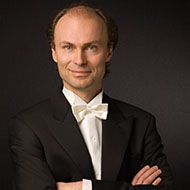At a Glance
WAGNER
Siegfried’s Rhine Journey, from Götterdämmerung 1873 | 12 mins
Siegfried is the son of Siegmund and Sieglinde. He is the grandson of Wotan, chief of the gods, and of a mortal woman whose name we never learn. Siegfried knows next to nothing of this heritage having been raised in isolation by the dwarf Mime. In Götterdämmerung Siegfried is also the husband of Brünnhilde, a former warrior maiden or Valkyrie, one of nine fathered by Wotan on Erda, the Earth Goddess. This means that Siegfried is married to his aunt. (This is not Leave it to Beaver!) LISTEN FOR: In today’s excerpt from Götterdämmerung, Siegfried and Brünnhilde have awakened from their first night together. In recognition of their union, Siegfried has taken a gold ring off his own finger and placed it on Brünnhilde’s: This is the ring of Wagner’s massive seventeen-hour Der Ring des Nibelungen, the ring about whose changing ownership the whole saga revolves. But Siegfried is not about to settle down in domestic bliss. . .
LISZT
Piano Concerto No. 2 in A major 1861 | 22 mins
Many think of Liszt as a piano virtuoso who filled his pieces with dazzling displays of high-velocity finger-work that careered dizzily up and down the entire length of the keyboard. This piece is more subdued and we sense the composer’s deep-seated desire to beautifully integrate the solo instrument into the symphonic texture.
HOLST
The Planets 1916 | 49 mins
Conductor Christian Reif offers these comments: “The title of Holst’s epic work suggests the music is specifically about the planetary universe, but I find it more personal. His ingenious ability to portray distinct characters in his music, paired with his astrological hints, give us a sense that he depicts different facets of humanity, from the primal physicality of Mars to the transcendent mysticism of Neptune, with beauty, happiness, quirkiness, and much more in between—this is a journey from the physical world to the metaphysical.”
PICTURE THIS
Mars, the Bringer of War: The association of Mars and war goes back as far as history records. Holst’s Mars is fierce and remorseless; the aspect of war Holst most wanted to express was its stupidity.
Venus, the Bringer of Peace: After the moon, Venus is the brightest object in our night sky. Astrologer Noel Tyl says, “when the disorder of Mars is past, Venus restores peace and harmony.” The dominant colors are the cool ones of flutes, harps, and celesta.
Mercury, the Winged Messenger: To astrologers, Mercury is “the thinker.” Holst offers up virtuosic, unstable, nervously changeable in music—in a word, mercurial.
Jupiter, the Bringer of Jollity: The most massive of the planets, possessing twelve satellites, named for the light bringer, the rain god, the god of thunderbolts, of the grape and the tasting of the new wine, of oaths, treaties, and contracts, and from whom we take the word “jovial.” Jupiter symbolizes expansiveness, scope of enthusiasm, knowledge, honor, and opportunity . . . [and] corresponds to fortune, inheritance, bonanza.”
Saturn, the Bringer of Old Age: Saturn is the outermost of the planets known in ancient times, and is “man’s time on earth, his ambition, his strategic delay, his wisdom toward fulfillment, his disappointments and frustrations.” This is another episode dominated by the sound of flutes and harps, but this time static, full of the suggestion of bells, and serene at the last. This movement was Holst’s favorite.
Uranus, the Magician: The first planet discovered in the age of the telescope. In astrology, Uranus rules invention, innovation, and astrology itself. Holst begins with a triple invocation (trumpets and trombones, then tubas, then timpani) that becomes galumphing dance. At the end, the apparitions disappear into the night.
Neptune, the Mystic: In astrology, Neptune means confusion and mystic rapport with other worlds. Neptune is invisible to the naked eye, and to Holst it speaks of distance, mystery, unanswerable questions. He makes of it another swaying slow movement full of the sound of shimmering harps and celesta, that dissolves in the voices of an invisible chorus of women.
Jeanette Yu is Director of Publications at the San Francisco Symphony.

